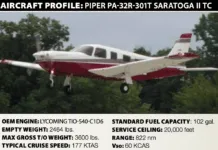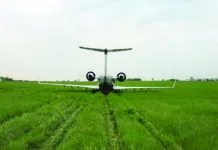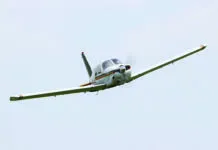A spectacular four-hour flight that was tracked on television to the bitter end culminated in a near vertical dive to a farmers field near Mina, S.D., in late October. Aboard the Lear 35A were four passengers – including golf great Payne Stewart – and two pilots. Even while the plane was cruising at altitude, it was apparent that the light jet had depressurized, from as yet unknown reasons.
The jet was flying from Orlando, Fla., to Dallas on an IFR flight plan when ATC lost communication with the airplane as it climbed on autopilot through FL370 toward an assigned FL390. It busted the assigned altitude and reached altitudes in the low to mid-forties.
The aircraft did not turn toward the west, as its intended flight plan would have dictated, but instead continued on a heading that took it far off course. Over the next several hours, several fighters intercepted the wayward Lear and reported that the windshield was heavily frosted.
In addition, the NTSB reported the cockpit voice recorder – which only contained the last 30 minutes of the flight – contains sounds of the cabin altitude warning horn blaring. This in itself documents cabin decompression. Of special significance is that the captain was a former Air Force pilot who reportedly was an instructor in the high altitude physiology (altitude chamber) course.
That the depressurization resulted in the incapacitation of the crew implies a catastrophic decompression or lack of oxygen from the oxygen system. Furthermore, it highlights the obvious weakness in the current rule regarding training and use of the life support systems in the upper atmosphere, as outlined in FAR 61.31(g).
Learjet Pressurization System
By design, when the cabin altitude of an early model Lear 35 reaches or exceeds 10,000 feet, an aneroid switch activates the cabin altitude-warning horn, illuminates the CABIN ALT caution light, and opens the manual control solenoid valve to isolate the automatic pneumatic circuits from the cabin outflow valve. The isolated outflow valve then holds its last selected position. This is intended to deactivate the automatic pressurization controller to stop the cabin altitude loss.
If the cabin pressure loss continues, the cabin altitude limiters activate at 11,000 feet to help maintain the selected cabin altitude. If the flight remains at altitude and the cabin reaches 14,000 feet, the passenger oxygen masks deploy and the overhead lights illuminate.
If circumstances require remaining at altitude, such as a very long overwater leg, then emergency pressurization must be selected by pushing the defog knob in and setting the windshield heat switch to auto. This funnels emergency bleed air through the pilots foot warmers and into the cabin. This air is tapped from the high and low speed compressors of both engines and is very hot. And while windshield heat is no longer available, the pressurization inside the cabin is adequate to keep the passengers and crew conscious and in control.
In fact, if the aircraft remains at altitude with emergency pressurization selected, the cabin becomes so hot that the left bleed air switch must be turned off in an effort to keep the heat tolerable. Even with the left bleed air off, it may be necessary to retard power on the right engine to reduce the inflow of hot engine bleed air. (Left engine bleed air off is recommended because the right air distribution system delivers air more evenly to the cabin and cockpit.)
Meanwhile the crew must begin the emergency descent procedure. This involves donning oxygen masks and extending spoilers and landing gear, then descending to 15,000 feet at 0.83 Mach, or 265 KIAS. Using this procedure the airplane can descend from 45,000 feet to 15,000 feet in 2 minutes 45 seconds. Thus if one or more passengers were unable to don their mask in the totally translucent cabin (fogged-up by condensation), they would be down to a survivable altitude before brain damage occurred.
When Safeguards Fail
The design of the Lears pressurization system is important because circumstantial evidence implies either a massive failure in the pressurization system or a rupture in the pressure vessel. Altitude chamber decompression tests have shown that, above FL370, either event could have instantly incapacitated the crew. However, given the relative youth of both pilots and the captains reported background, a more likely scenario is that the crew was unable to get oxygen from the emergency bottle after the sudden decompression.
In outlining potential scenarios, some have speculated the crew failed to check the oxygen bottle, located in the nose section, during the pre-flight inspection. In addition they would have omitted the oxygen system actions specified on the Before Starting Engines checklist.
While the oxygen bottle is supposed to remain ON, most Lear pilots turn it off at the end of a flight so that any minor leaks in the system wont deplete the oxygen overnight. In addition the oxygen bottle is normally turned off for safety reasons during maintenance inside the hangar.
Two days prior to the mishap, the airplane reportedly had the left engine modulating shutoff valve replaced. The system was pressure checked on a short flight and the aircraft was returned to service. If the supply bottle had been left OFF after the hangar maintenance, the crew on the test flight would also have missed the oxygen system checks on both the pre-flight and before-start checklist.
There is a design deficiency that adds to the potential for human error – a Murphy factor that could have been involved in this accident.
The cockpit oxygen quantity gauge for the oxygen supply cylinder in the early model Lear 35 is mounted on the right side of the center instrument panel, almost directly in front of the copilot. The gauge reads the pressure downstream of the pressure-regulator and shutoff valve. If the oxygen cylinder is turned off the direct reading gauge continues to read normal oxygen pressure unless the line is purged.
Absent a leak in the line, the gauge will show normal oxygen pressure until the crew tests the system in accordance with the before-start checklist. Once the crew breathes through the masks, the pressure falls to zero if the bottle is off.
In the rush to get going and with happy chatter all around, it is not unheard of that the oxygen mask check is overlooked or omitted, and the pressure gauge is the evidence that the oxygen system is up to snuff. However, if the valve is off the gauge may still indicate a normal pressure, yet the oxygen is unavailable in flight.
A simple fix is to employ a simple O2 OFF annunciator light that illuminates when the oxygen cylinder is not ON. The early Lears are not the only jets that have this design deficiency. The Lear 35 checklist attempts to avoid the error by requiring operational checks of the mask, and the FlightSafety International Pilot Training Manual warns against the hazard. Yet anyone who spends any time around business jets knows of repeated instances where a flight or series of flights has been made with the oxygen cylinder turned off.
Rules Vs. Reality
If in fact the oxygen bottle was turned ON and the oxygen system was operating properly, then the crew must have been ignoring the oxygen mask requirements of FAR 135.89(b). This regulation requires that, above FL350, at least one pilot must wear and use an oxygen mask. The rule is specifically designed to prevent the kind of accident Payne Stewarts Learjet suffered.
Even above FL250, a pilot must wear and use an oxygen mask if, for any reason, one pilot leaves the cockpit. With a properly operating oxygen system, the accident could not have happened if either pilot had been wearing an oxygen mask. While it is admittedly uncomfortable to wear the mask, FAR 135 rules are based on the lessons from past mishaps. Ignoring the oxygen mask rule is a possible finding in this accident.
A contributing factor in the accident may also have been that, in an executive jet, it is not uncommon for a cockpit crew member to go aft and act as flight attendant, serving drinks and possibly even a meal. Though the practice is widespread, it runs counter to FAR 91.105(a), which requires both pilots to remain in the cockpit unless they need to perform duties in connection with the operation of the aircraft or to use a lavatory. Though some may consider beverage service something necessary for the operation of the aircraft, the conservative interpretation is that it should not be done.
It is noteworthy that the flight departed around lunch time, but investigators have not yet said whether catering was provided to the plane and the likely position of each crew member at the time of the decompression. Regardless of the possibility of cabin service, however, the pilot flying was not wearing his or her oxygen mask, assuming the supply bottle was ON and the system was functioning properly.
High Altitude Physiology
Another obvious lesson from the accident is that pilots of high-flying aircraft should pay more attention to high altitude physiology training. Regulations require only ground training by an authorized instructor – which may simply be inadequate, especially given the fact that the subject is routinely pencil-whipped during training.
Experienced high-altitude pilots can hardly help but conclude that no pilot is adequately trained in high altitude physiology unless he or she has attended an altitude chamber course, offered by the FAA for approximately the cost of a ski-lift ticket. Military chambers are also scheduled through the FSDO.
Just as you cannot read a book and learn to ski or ride a bicycle, neither can you read a manual or watch videotape and be competent if a sudden decompression occurs.
The actual event is very frightening, to be sure, but you also have to accomplish every step of the pressurization-loss procedure absolutely correctly the first time and in zero visibility, due to condensation in the cabin and cockpit.
When the regulation was originally written, the requirement for a chamber flight was left out because many thought there were not enough chamber facilities available. However, the worldwide resources of the military services could be made available. In addition some universities, such as the University of North Dakota, now have altitude chambers.
Of special importance in high altitude physiology training is pressure breathing. Only by actually doing it in an altitude chamber can a pilot learn how to pressure-breathe – or reverse breathe – at high altitude. This involves allowing the oxygen system pressure to inflate your lungs and requires you to forcibly exhale.
The role of the oxygen system is to keep your blood oxygen saturation at 90 percent to 98 percent, which is what it would be at sea level.
In an unpressurized aircraft at lower altitudes, the pressure regulator supplies oxygen in the proper ratio to keep the partial pressure of oxygen in the lungs at 60 mm Hg to 100 mm Hg. However, when you hit 34,000 feet 100 percent oxygen is required, and the pressure regulator provides this automatically.
In climbing above 34,000 feet, the oxygen must be under pressure to keep the desired sea level oxygen blood saturation. This is because in the rarefied atmosphere above FL340, the partial pressure is too low for your lung alveoli to absorb adequate oxygen.
At 40,000 feet, using only normal 100 percent oxygen, your body absorbs oxygen as well as it does in ambient air at 10,000 feet. This starts the onset of oxygen deficiency symptoms or hypoxia.
That, of course, assumes you are climbing to altitude unpressurized. A pressurized cabin that suffers a sudden decompression makes it a whole new ball game.
Altitude chamber tests have shown that you may not remain conscious when a rapid or explosive decompression occurs. It depends on your age and physical condition that day. This is why FAR 135 requires that one pilot wear an oxygen mask above FL350.
Defining Proper Technique
The accident also underscores the dichotomy between FAR 135 and FAR 91 oxygen mask requirements. FAR 91.211 does not require a mask to be worn by one pilot above FL350, as long as both pilots have quick-don masks. Yet altitude chamber tests on volunteers in the 1960s and 70s showed very clearly why it is necessary.
With a sudden decompression at FL410, more than a third of the test subjects were rendered unconscious. Others lasted only two seconds before passing out. The five-second allowance seems excessive because the pilots did not have five seconds in which to get the oxygen masks on.
Validating these tests was the experience of an Air Force crew flying a CT-39A Sabreliner. The cabin door burst open at FL450, rendering the aircraft commander unconscious instantly. However the co-pilot (a former fighter pilot) saved the day by having worn his P-3 helmet, which had the oxygen mask dangling just beside his face. He quickly donned his mask and prevented a tragic accident.
Unfortunately the commander sustained the worst possible type of decompression sickness, central nervous system disorder. As they descended and the pilot began to revive, he became combative and began fighting wildly for control of the aircraft.
A passenger bravely came forward past the open door and held him off the controls. Once on the ground he attacked three medics who responded to the emergency.
For three days he was berserk and restrained in critical condition. In a last-ditch effort to save his life, the doctors placed him in a hyperbaric chamber for compression therapy. The pressure was lowered to below sea level, forcing the nitrogen bubbles to be re-absorbed into his body fluids and he was returned to the hospital. It was later theorized that a nitrogen bubble had stagnated at a critical point in his brain.
Fortunately, thanks to the co-pilot, the passenger who restrained him and the medical team, he recovered physically and mentally and soon was returned to flight status.
This Lear 35 mishap is the third decompression accident in a Learjet and the fifth in recent memory in corporate/business type aircraft. When you consider that these aircraft are transporting the movers and shakers of the worlds economy, it is clear that the oxygen mask requirements for Part 91 operations are illogical, and there is plenty of test data to prove the point.
In addition, its clear that Part 135 operators will be well served to use this as a wakeup call to treat oxygen system preflight checks seriously.
The NTSB says the investigators field report will be available in the next two months. Although the report may shed some light on the accident, it is also possible that some of the mystery will never be solved.
Also With This Article
Click here to view “High Altitude Environment.”
Click here to view “Pressurization Failures.”
-by John Lowery
John Lowery is an aviation safety consultant, author of the book Professional Pilot and former corporate and Air Force pilot.



